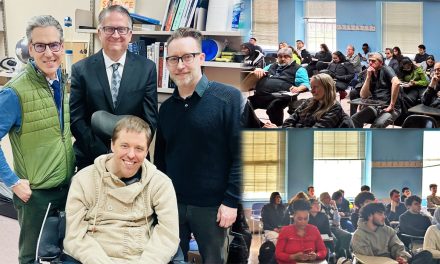New York State Senator Andrew Lanza visited the College of Staten Island (CSI) for a briefing on the research of two CSI faculty members whom the Senator has funded.
Dr. Jeff Bussolini of the CSI Sociology department shared his observations with Senator Lanza and CSI President Dr. Tomás D. Morales regarding sociological research on the Staten Island Ferry and how Ferry riders perceive this 103-year-old Staten Island icon, and Dr. William Wallace of the Biology department reviewed his research on three local marshes, noting that much of the metal contamination found had occurred within the past four to eight years.
It is in three years of research that Bussolini, associate professor, and Ananya Mukherjea, assistant professor, have uncovered many social phenomena that Ferry riders experience on the 27-minute-long ride across New York Harbor. Working with their Sociology 270 class, the researchers often teach their class at the Ferry terminal to allow their students to conduct fieldwork and observe the social trends created by this mode of transportation. Thanks to the funding provided by Senator Lanza, Bussolini and Mukherjea were able to work with grad students, as well as undergraduate students, to conduct surveys and interviews of Ferry riders. By using audio and video interviews, Bussolini and Mukherjea have been able to record the “Ferry experience” of regular Ferry riders, as well as tourists.
According to Mukherjea, “the Ferry feels like a plaza,” allowing for a more social setting when compared to other forms of transportation. Its wide-open space feels less like another leg of the commute to work, and more like 27 minutes to “read a newspaper, put on make-up, or enjoy the view,” Bussolini states. Being a former frequent Ferry-rider, Senator Lanza shared many of the same sentiments by stating that many riders often look forward to this part of their commute because it allows them to relax for a short while. Professors Bussolini and Mukherjea also uncovered in their research that the ethnic distribution on the Ferry reflects the diversity of New York City.
Wallace, associate professor, briefed Senator Lanza and Dr. Morales on his evaluation of the Staten Island marshes for trends in sediment contamination.
As a native Staten Islander, growing up and playing around these wetlands, Senator Lanza found this research project to be significant for all Staten Island residents. Wallace focused his research on three local marshes: Meredith Marsh, Travis Avenue Marsh, and the Richmond Creek Marsh. He examined these three sites for three metals—cadmium, copper, and zinc—to determine their concentration levels within the soil that surrounds the marshes. Most of Wallace’s research shows that much of the metal contamination that was found in the marshes had occurred within the past four to eight years.
This leaves the question of what caused this sudden increase in contaminants. Wallace suggested many factors that may have played a role in this matter: the large industrial population that surrounds the Arthur Kill, the former Fresh Kills and Brookfield landfills, the dredging of the Arthur Kill, or perhaps the low flushing of the marshes caused by the tides from New York Harbor and Raritan Bay, which force the sediments/pollutants to remain in the Arthur Kill.
Wallace’s conclusions show that there was a modest recovery in the sediment of the cadmium pollutants, but his research does not show “any clear and long-term recovery from metal sources.”
This leaves many wondering whether or not the Clean Water Act is working.
Senator Lanza stated that he “feels that all of the Staten Island elected officials should take these matters into consideration” so they can adequately address if there is any correlation between this, and Staten Island’s high-cancer propensity.

















